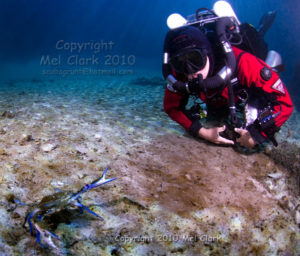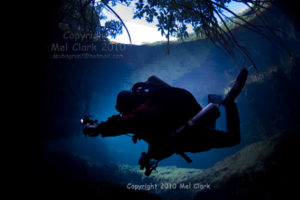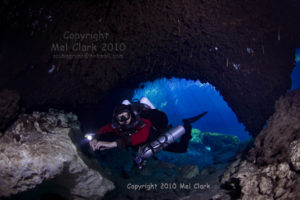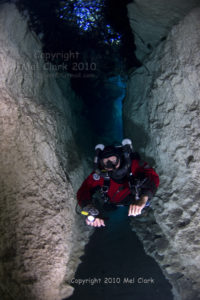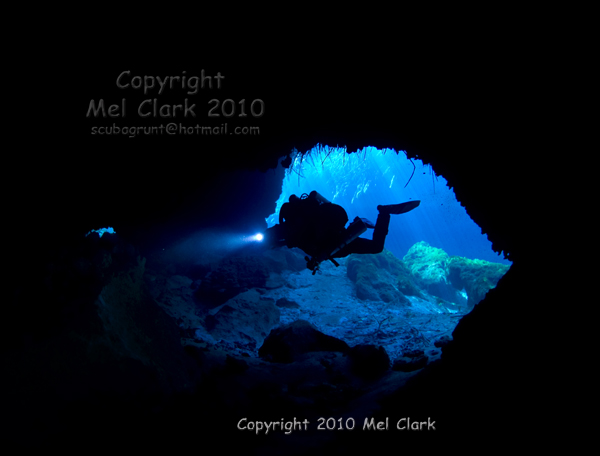In mid January 2010 I took the rEvo CCR cross over course from Mel Clark. The rEvo is a relatively new CCR on the market and is produced in Belgium. There are three versions of the unit as the standard, mini and micro in the physical size of the unit. The unit is designed as a back mounted counterlung Rebreather, meaning there are no counterlungs on the front of the body, keeping it nice and clear for photographers, people with little real estate, meaning space in front or people who do not like front mounted counterlungs at all.
Etienne, a good friend of ours was so kind lending me his rEvo CCR in order to do the cross over course. The new rEvo owner has the option to have the unit configured as either a manual CCR, electronic CCR or a hybrid with the manual and electronic version combined. Etienne’s unit was configured as a manual CCR while Mel’s CCR was configured as a hybrid version, so I had the opportunity to look at them both in detail.
The rEvo is a very thin and streamlined Rebreather with the counterlungs protected within a metal box on the back, protecting them from damage if diving within wrecks or caves. Each rEvo has 4 oxygen sensors and two controllers or po2 display’s. Depending on owner preference and made to buyer specification they can be both rEvo oxygen po2 displays called Dream, or a Dream and the Canadian manufactured Shearwater electronics hand set display that are either just a po2 display of full blown decompression computer laced into the oxygen sensors keeping the decompression information up to speed and in real time. Again I was lucky that Etienne’s unit had one Dream and one Shearwater po2 display while Mel’s unit had two Dreams and a Shearwater decompression computer wired into the sensors to display the oxygen po2 while calculating the inert gas intake.
The reason there are 4 oxygen sensors as to the regular 3 sensors seen in most CCRs is that one dream is always on only one sensor, not sharing any wires, battery, cables or whatnot, making that one display truly independent and redundant, and great for cross reference to the other display that still has the regular 3 sensors with voting logic. One particular feature on the rEvo is the two independent absorbent canisters configured in line, one after the other. This allows to change only one of the absorbent canisters when staying within two hours of bottom time. This feature is particular nice when doing Rebreather try outs when not the whole load of absorbent is used, and the unused absorbent does not have to be thrown away.
As Mel was dragging me through the pool of pain (Cenote Eden) I went through all the CCR related emergency drills, learning them from the rEvo unit point of view, with new buttons to use on different locations as the oxygen and diluent manual inflator buttons are located at the but of the unit. The work of breathing is quite nice for a back mounted counterlung Rebreather. Once done with the pain part we went the next day to Cenote Manati. Due to strong winds in the salty ocean stuff we could not dive the ocean but enjoyed some really nice diving, full of emergency drills and scenarios found in a regular CCR course while floating through the mangroves of Cenote Manati. The cross over course is a couple of days shorter then the regular CCR course as I did not have to learn the basics of Rebreather diving part but just the unit specific drills, details, ins and outs including pre dive unit preparation, maintenance and post dive care.
Once I had completed my training dives and bottom time Mel took her camera in the water and squeezed some nice images through her lens of Cenote Manati with me blocking the view. The reason I am still taking courses is that I do not want to lose the feeling to be a student. I still want to learn new stuff and still enjoy the learning experience. Additionally I can now teach CCR cave courses and CCR normoxic trimix courses with my students diving the rEvo as I have completed the diver training program allowing me to understand what my student is doing on his unit.
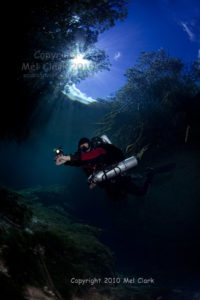
It was great to meet Mel and hang out some days with her, and learn a bunch. It’s always good to see how other Rebreather divers dive in other regions or other environments such as the cold water environment. I truly enjoyed the experience. All images within this article are authored, copyrighted and published with permission from Mel Clark.

